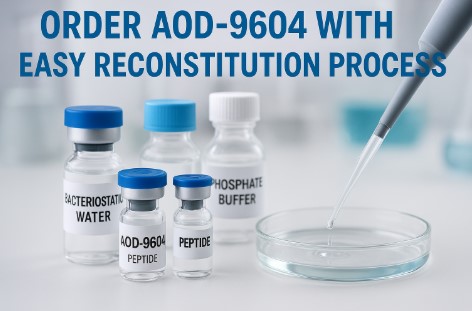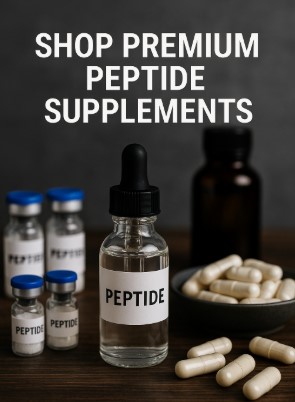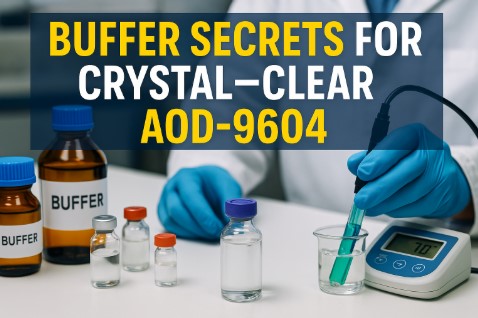The Peptide Research Revolution and Buffer’s Hidden Role
As peptide research pushes new frontiers, the spotlight on AOD‑9604 continues to intensify. Labs across the globe rely on this specialized peptide for innovative metabolic and regeneration studies. Yet, beneath the headlines and published findings, many researchers quietly agree: the success of any experiment involving AOD‑9604 often comes down to the clarity and stability of the solution itself. And that’s where choosing the right buffer is more than a technical afterthought—it’s the foundation for reliable, repeatable results.
What Makes AOD‑9604 Unique—and Why Buffer Choice Is Crucial

AOD‑9604, a fragment of the human growth hormone, has a nuanced structure that grants it impressive research potential. But its very structure also makes it susceptible to environmental changes. The wrong buffer can easily tip the scales, leading to cloudiness, precipitation, or even complete peptide degradation. This is why top laboratories—and trusted suppliers like Modern Aminos—prioritize not just peptide quality but also education on reconstitution and buffer selection.
For researchers aiming to order AOD‑9604 with easy reconstitution process, understanding how buffer chemistry influences peptide solubility can make all the difference between a crystal-clear solution and wasted samples.
What Is a Buffer, and How Does It Affect Peptide Solutions?
At its simplest, a buffer is a solution formulated to maintain a consistent pH. In the world of peptides, this means helping to prevent sudden shifts in acidity or alkalinity—shifts that could irreversibly damage the delicate structure of AOD‑9604. But buffers do more than just protect pH. They help keep peptides soluble, minimize aggregation, and can even slow degradation processes during storage.
Common Buffer Options for AOD‑9604
The choice of buffer for AOD‑9604 should never be left to chance. Below are the most popular options, each with unique advantages and limitations:
- Sterile Bacteriostatic Water
This is often used for short-term experiments. It prevents bacterial growth but doesn’t buffer pH, so it’s best for immediate use rather than long-term storage. - Phosphate Buffered Saline (PBS)
PBS stands out for its compatibility with biological systems and its pH of around 7.4, which closely matches physiological conditions. Researchers often find PBS reliable for keeping AOD‑9604 stable and fully dissolved. - Acetate Buffer
With its mildly acidic pH, acetate buffer can help dissolve peptides that struggle at neutral or alkaline pH levels. However, it’s not suitable for all protocols. - Tris Buffer
For applications requiring slightly alkaline conditions, Tris can be a good option, especially if AOD‑9604 demonstrates greater stability at pH 7–9.
Secondary Topic Context: Buffer Chemistry and Peptides
It’s important to recognize that these buffer selection principles aren’t limited to AOD‑9604. Virtually all peptides require careful handling and thoughtful buffer choice to maximize performance in laboratory settings.
Why Do Peptides Like AOD‑9604 Become Cloudy?
Even experienced scientists sometimes find their peptide solution turning cloudy or forming visible particles. In most cases, this is a direct result of poor buffer selection—wrong pH, high salt concentration, or improper handling. Peptides may also aggregate if the buffer does not sufficiently mimic the conditions needed to keep them stable and dissolved. Ensuring you’re using a recommended buffer—like a low-salt PBS at pH 7.2 for AOD‑9604—often solves these issues.
Factors to Consider Before Choosing a Buffer
Modern Aminos recommends starting with a review of your experimental protocol and the manufacturer’s guidance. Key factors include:
- Optimal pH for Stability
For AOD‑9604, a neutral to slightly acidic pH (typically between 6.5 and 7.4) offers the best solubility and protection against degradation. - Buffer Concentration
Too weak, and your solution’s pH can drift; too strong, and you may introduce unwanted interactions. A concentration in the range of 10–50 mM is typically safe for most peptide work. - Sterility and Endotoxin-Free Handling
Always use sterile, laboratory-grade buffers to avoid introducing contaminants. Modern Aminos supplies AOD‑9604 with accompanying purity and handling documentation, making it easier for researchers to maintain high standards in their labs. - Compatibility with Downstream Applications
If your research involves cell cultures or sensitive analytical equipment, ensure your chosen buffer won’t interfere with these processes.
Step-by-Step Guide: Achieving a Crystal-Clear AOD‑9604 Solution
With the right buffer in hand, reconstituting AOD‑9604 can be a straightforward, reliable process.
Here’s a proven protocol:
- Bring both peptide and buffer to room temperature to avoid temperature-induced precipitation.
- Check and, if necessary, adjust the buffer’s pH to within the recommended range before mixing.
- Add the buffer slowly along the wall of the vial containing lyophilized AOD‑9604, rather than dumping it in quickly.
- Gently swirl the vial (do not shake vigorously) to allow for even dissolution.
- Inspect the solution under bright light; a truly crystal-clear solution means you’ve succeeded. If cloudiness remains, reassess pH and consider switching to a different buffer or adjusting concentration.
Avoiding Common Buffer Mistakes in the Lab

Despite best intentions, some common mistakes can sabotage even a well-prepared solution:
- Using non-sterile water or expired buffer: Always opt for fresh, sterile buffers designed for laboratory use.
- Ignoring pH drift: It’s critical to measure pH just before use, especially if your buffer has been stored for weeks.
- Not considering salt effects: Some peptides, including AOD‑9604, are sensitive to ionic strength; using high-salt buffers can promote aggregation or cloudiness.
Labs that shop premium peptide supplements online from trusted sources often benefit from detailed handling instructions, reducing these mistakes and ensuring more reliable research outcomes.
Advanced Troubleshooting for Stubborn Solutions
If your AOD‑9604 solution remains cloudy or forms precipitates, try these professional strategies:
- Switch to a buffer with a different pH (within recommended range).
- Reduce salt concentration, especially if using PBS or Tris.
- Use a gentle pipette to break up clumps rather than vortexing.
- Filter the solution through a 0.22 µm syringe filter if sterility and clarity are required for downstream applications.
Remember, Modern Aminos technical support is available for researchers facing persistent challenges, with custom recommendations based on real-world lab experience.
Storage and Handling: Maximizing Peptide and Buffer Performance
Proper storage is as crucial as initial preparation. Always aliquot reconstituted AOD‑9604 into small volumes to minimize freeze-thaw cycles, and label vials clearly with buffer type and preparation date.
For most applications, storage at –20°C is recommended, though short-term storage at 2–8°C is generally safe for a few weeks.
Many experienced labs create a “buffer log” to track each batch’s lot number, pH, and any adjustments made. This simple step dramatically increases the traceability and reproducibility of peptide-based experiments.
Case Example: Buffer Selection Solving Real Research Problems
Consider a research team that repeatedly observed precipitation in their AOD‑9604 samples, despite following standard protocols. Upon review, they discovered their buffer pH had drifted to nearly 8.0 due to long-term storage. Switching to freshly prepared PBS at pH 7.2 not only eliminated the precipitation but also improved the consistency of their results. This example underscores the importance of meticulous buffer preparation—something Modern Aminos consistently educates its customers about.
FAQs: Clearing Up Buffer and Peptide Myths
Can I use distilled or tap water for AOD‑9604?
No—only use sterile, lab-grade water or an appropriate buffer to ensure solution clarity and prevent contamination.
How long can reconstituted AOD‑9604 be stored?
With proper aliquoting and buffer choice, AOD‑9604 is typically stable for up to a month at 2–8°C or several months at –20°C.
Does Modern Aminos provide buffer recommendations?
Yes, each shipment includes best-practice guidelines and storage instructions, supporting successful peptide handling from day one.
Staying Up-to-Date: Resources and Community Support
Peptide science continues to evolve, with new insights on buffer systems and reconstitution emerging regularly. For those seeking more guidance or wishing to share their expertise, participating in online communities and reading trusted resources can be invaluable. If you’re interested in expanding your knowledge or contributing your own lab experiences, explore articles and submissions at WriteForUsHealth, where research professionals connect and exchange practical tips.
Conclusion: Buffer Choice as a Cornerstone of Peptide Research
Ultimately, choosing the ideal buffer for crystal-clear AOD‑9604 solutions is one of the most impactful steps a laboratory can take. The difference between clear and cloudy, stable and unstable, is often determined in those early moments of buffer preparation. With proper planning, protocol adherence, and the support of reliable suppliers like Modern Aminos, researchers can unlock the full potential of AOD‑9604 for groundbreaking studies in metabolic science and beyond.

